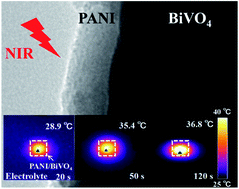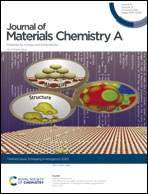Photothermal effect-enhanced photoelectrochemical water splitting of a BiVO4 photoanode modified with dual-functional polyaniline†
Abstract
Both bulk charge separation and surface reaction kinetics are highly important to semiconductor-based water splitting photoanodes. Polyaniline (PANI) with dual functions of hole transport and photothermal conversion is introduced to construct PANI/BiVO4 composite photoanodes. On the one hand, bulk charge separation is enhanced due to the formation of a p–n heterojunction. On the other hand, the charge separation efficiency is further improved because of the temperature elevation induced by the photothermal effect of PANI. In addition, cobalt phosphate (Co-Pi) as a cocatalyst is introduced to accelerate the surface water oxidation reaction, which is also further promoted via the photothermal effect of PANI. Assisted by NIR light, the resultant Co-Pi/PANI/BiVO4 photoanode achieves a remarkable water oxidation photocurrent of 4.05 mA cm−2 at 1.23 VRHE (V vs. the reversible hydrogen electrode), over 300% higher than that of the pristine BiVO4 photoanode. The introduction of the photothermal effect can be extended to improve the PEC performance of other photoelectrodes, such as Fe2O3, WO3 and TiO2.

- This article is part of the themed collection: Journal of Materials Chemistry A Emerging Investigators


 Please wait while we load your content...
Please wait while we load your content...